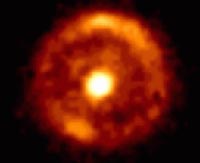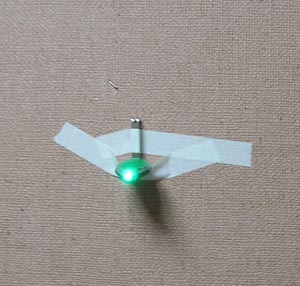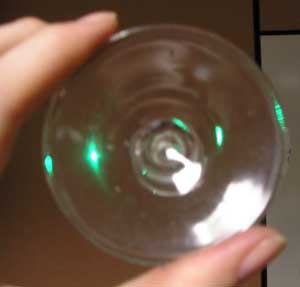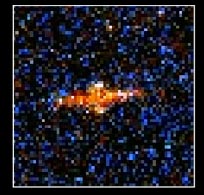The Universe in a glass of Wine


An Einstein ring.
A distant galaxy is imaged as a ring when light is bent by the
gravity of a nearer galaxy, and a green LED is imaged by the bottom of a wineglass.
The Universe in a glass of Wine


An Einstein ring.
A distant galaxy is imaged as a ring when light is bent by the
gravity of a nearer galaxy, and a green LED is imaged by the bottom of a wineglass.
Introduction
Light bends when it passes through the gravity potential of a massive object. The bent light can create distorted images of the source.
Material
Assembly
Turn on the propane torch, put on eye protection and gloves.
Direct the flame from the torch so that the tip of the blue flame hits the middle of the stem of the wineglass. Hold the wineglass by the rim so that the base is a half-inch (1 cm) above the table top. Rotate the glass so that the stem is heated all the way around. After a minute or so the stem will begin to melt and the bottom of the wineglass will drop to the table. Lift the top of the wine glass away, then melt a rounded top onto the stem that rests on the table. Let the pieces of glass cool for 5 minutes.
To Do and Notice
Look at the LED through the wineglass base. Have someone hold the LED at a distance from the wine glass base, rotate the base to the side.
Or tape the LED to a wall

Move the wineglass side-to-side and also change its distance from the LED.
What do you see?
Notice the shape of the image of the LED.
Explorers report seeing rings of light, dots of light, arcs and lines of light.
What's Going On?
The gravity field of a massive object bends light.
A distant light source can be imaged by closer massive objects.
A glass or plastic lens also bends light and may make an image of a distant object.

Four point images (with more dimmer ones) are made by the curved base of the wineglass.
Examples of these gravitationally produced images are available online
Here is one comprehensive source: http://astro.hi.is/lens/pict_th.html



Gravitational images which form a 4 point cross, an arc and a
line. These were all acquired by the Hubble Telescope.
|
Scientific Explorations with Paul Doherty |
|
8 November 2004 |